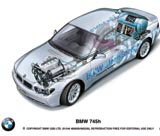Green machines
Nargess Shahmanesh-Banks takes a look at the road ahead for Green car design

The Green car will be the future of driving in the next ten years or so. The irony is that despite an entirely different and innovative interior, concept or production vehicles have so far had a very conventional design.
This is partially understandable since the idea of the Green car is still a fairly new concept. Few designers have had the chance to debate the issue and find new solutions. In addition, this is the automotive industry, where most designers are complete car nuts, who perhaps can’t or don’t want to see any further than the conventional box look. So should a car that runs on alternative energy be designed like a regular combustion engine car?
Volkswagen Group’s newly appointed design director Murat Günak believes most designers would enjoy the challenge of having the freedom to design exciting shapes for future projects. Sustainability doesn’t have to necessarily penalise creativity.
Peter Horbury, executive director of design at Ford’s Premier Automotive Group – which houses Aston Martin, Jaguar, Volvo and Land Rover – agrees that if new technology gives the designer the opportunity to be more adventurous or create something new, then he should take it on board. Yet he doesn’t see why a car’s shape should necessarily change to reflect technology per se.
VW brand design director Peter Schreyer agrees in that if the package allows for it, then an alternative vehicle should perhaps look different to the regular car. ‘A mid-engine car, for example, has different proportions to a front-engine car. Therefore, it makes sense that a hybrid car (one that combines an engine with an electric motor) should allow for a very different proportion,’ he explains.
There is another aspect to this. Someone who buys an alternative fuel car is making a clear statement about his responsibility to the environment. As Julian Thompson, head of Jaguar’s Advanced Design Studio points out, they would probably want the car to look different. He thinks this is where Toyota went wrong with its first Green passenger car, the Prius.
Launched back in 1997, it was the world’s first mass-produced, electric-gas hybrid vehicle. The new model, due out by the end of the year, admits the designer, ‘is funkier and much more in keeping with how I would expect a car with this technology to look like’. But does it really push enough boundaries?
Thompson’s position at Jaguar means he is always on the lookout for future ideas. For him, the modernity of the technology inside should be apparent in the design and a Green car has to look caring. ‘It should look less aggressive, without necessarily looking cute,’ he says.
Romulus Rost who heads VW’s interior design team agrees. He believes that what is interesting about car design is the idea of working towards finding new formal languages. ‘If you are showing new engines and techniques, then the ideal thing would be to find a new design language that reveals that technology,’ he explains. He thinks it is important to try to find a form that says ‘this is a different car’. It would be a shame, he explains, to have a car with interesting technology that no one can see.
For Melinda-June Jenkins, an Audi senior designer in colour and trim, the argument is more basic. She thinks the car is not an object that can be Green. ‘An alternative should be riding a bicycle,’ she says sarcastically.
Replacing the steering wheel is not seen as a viable option. Indeed, Jenkins sees this as a ridiculous notion, because it goes against the nature of driving. Günak also sees the future interior remaining automotive in look. ‘Although it is technologically possible not to have the look we have now, as soon as we move away from it, the emotional side will die,’ he adds.
For Horbury this feature is the obvious way to control a car and this seems to be the general consensus. Thompson adds that you have to find a better solution to the steering wheel if you wish to replace it.
‘I remember the days when we used to have “automatic” written in bold chrome at the back of the car to show off the technology,’ says Horbury. Nowadays, he thinks there is no longer the need to be so showy.
Thompson says many current car design cues are all about performance. ‘The regular car’s design is about traditional car values: performance, fuel consumption, affluence and so on,’ he says. Which follows that as the Green car is a statement against all those values, it should be more about modern attitudes to design.
Thompson mentions furniture, product design and architecture as disciplines in which people’s needs are taken into account, as well as ecological aspects. ‘There needs to be a more honest interpretation on behalf of the designers,’ explains Thompson. ‘With Green cars we have the opportunity.’
-
Post a comment




